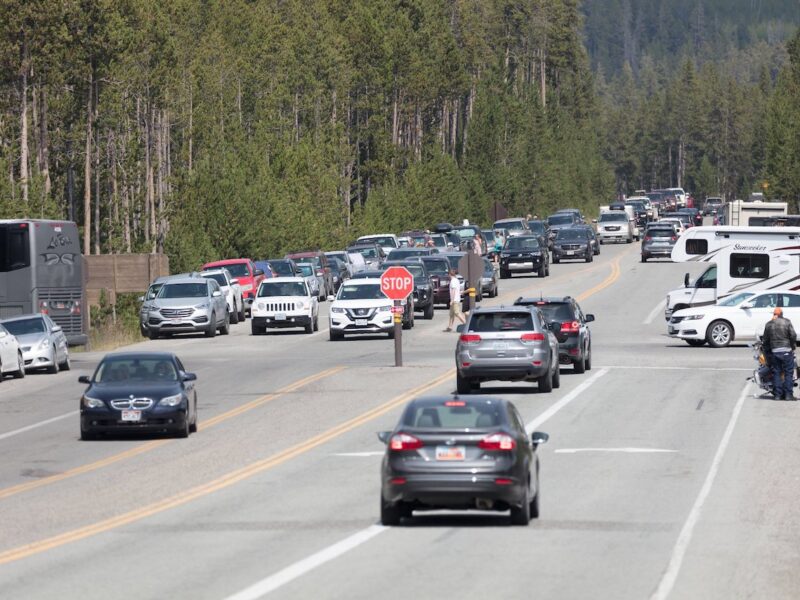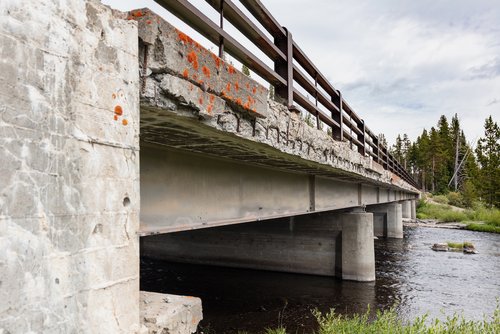
Traffic backs up at Norris Junction in Yellowstone National Park in this September 2017 file photo. Park planners are working to ease congestion here and at a handful of other especially busy spots in Yellowstone. (Courtesy photo from Jacob W. Frank/National Park Service)
By Ruffin Prevost
CODY, Wyo. — With the advent of warmer weather in Yellowstone National Park and Memorial Day approaching, tens of thousands of out-of-state visitors will be arriving to kick off the summer season. Or as park employees and locals call it: construction season.
Yellowstone Superintendent Cam Sholly earlier this month highlighted some of the park’s major summer construction projects during a National Parks Day luncheon in Cody. Sholly and Grand Teton National Park Superintendent Palmer “Chip” Jenkins, Jr. also outlined how visitor travel studies conducted in both parks have informed their decisions about dealing with traffic.
A detailed Yellowstone visitor survey found that a majority of people are not bothered by traffic jams caused by wildlife or congestion around popular sites.

While some park employees, locals and repeat visitors express frustration with traffic in the park, most first-time visitors say it doesn’t bother them, Sholly said. Last year, 70% of recreational travelers in Yellowstone were first-time visitors.
For those among Yellowstone’s 4 million or more annual visitors who are hoping the park will add new roads or other major transportation infrastructure, “that’s not going to happen,” Sholly said.
The preservation-focused mission of the National Park Service means Yellowstone and many other parks are more likely to limit visitor access than build new roads.
And with an extensive backlog of deferred maintenance, Yellowstone is focusing on repairs and improvements to existing roads and bridges, as well as to drinking water and wastewater systems.
Sholly said visitors can easily travel most of Yellowstone’s roads at the posted speed limit, typically 45 miles per hour. Ongoing problems from congestion occur mainly in a few areas: Old Faithful, Norris Geyser Basin, Midway Geyser Basin and the rims around the Grand Canyon of the Yellowstone River.
“I could cap visitation tomorrow at 2 million, and if a grizzly jumped out, every car on that section of road is going to cause a traffic jam,” Sholly said.
A 2021 pilot program using a driverless electric shuttle in Canyon Village “worked out pretty well,” Sholly said, moving 10,000 people using two 10-seat shuttles. That program showed the technology could work and that people would use the free shuttles if they were convenient.
Major shuttle system unlikely

But while similar small-scale shuttles may help in congested developed areas with limited parking, a recently completed feasibility study all but ruled out the idea of an 18-mile shuttle system between Madison and Old Faithful. The study found the system would cost at least $50 million in capital investment. It would require building new, 600-spot parking lots at both locations and cost $12 million annually to operate. The finances and logistics for a park-wide shuttle system were even more challenging.
“People have told us that they would support a shuttle system in Yellowstone. Like, 95% support it. As long as they don’t have to use it,” Sholly joked, drawing laughs from a crowd of locals unlikely to leave their cars at home.
Sholly said park planners don’t intend to curb visitation to Yellowstone now or in the near future, and any limits on travel would come only after extensive public input.
But planners are working on ideas to ease congestion at the park’s most popular spots, as well as broad, long-term strategies for what Sholly calls “more aggressive visitor-use management actions” when such measures inevitably become unavoidable.
In Grand Teton National Park, where many of the park’s roads run along a flat valley floor, “there’s not a dominant travel pattern” for visitors, Jenkins said.
“When they come into view of the Tetons, they’re so overwhelmed by the view, all they’re trying to do is to figure out how to pull over and take a picture,” he said. “Our turnouts have an incredibly high rate of use because people are just trying to soak in the view.”
A study completed in 2018 found that people stop in eight to 10 different locations while visiting Grand Teton, but not for very long at each spot.
The longest duration median stay is at Jenny Lake, for an hour. Next is a half-hour stop at the Craig Thomas Discovery & Visitor Center. Most other stops last 10-15 minutes, Jenkins said.
Jackson-area residents think of Grand Teton as a “local” park, and many are heavy users and vocal advocates for their visitation preferences. But locals make up only 5% of total Grand Teton visitation, Jenkins said.
Both superintendents said their efforts are focused mainly on serving the overwhelming majority of visitors whose needs are not best addressed by increased development or more limited access. And solid data from visitor studies completed in both parks are helping them make better decisions.
“The quality of the data that we have to base decisions on, I think, is a lot better,” Sholly said.
“Ten years ago, we were, like, guessing,” he said. “And what we found is what we think visitors think and what they actually think are many times two different things.”
Summer construction

Major construction projects in Yellowstone and Grand Teton this year will include:
• Wastewater and drinking water repairs and improvements at Canyon Village, Grant Village, Old Faithful and Mammoth Hot Springs.
• Removal and replacement of the Lewis River Bridge, located 10 miles north of Yellowstone’s South Entrance.
• Rehabilitation and repaving of a 20-mile section of Yellowstone’s Grand Loop Road between Old Faithful and West Thumb, last repaved in 1987.
• Replacing the structurally deficient Yellowstone River Bridge east of Yellowstone’s Tower Junction, built in 1963, with a new 1,285-foot-long, 175-foot-high steel girder bridge.
• Completion of repairs to flood-damaged sections of Yellowstone’s Northeast Entrance road between Lamar Canyon and the Northeast Entrance.
• Continuing rehabilitation and reconstruction of the Moose-Wilson road south of the Laurance S. Rockefeller Preserve in Grand Teton National Park.
Visit the Yellowstone and Grand Teton website road pages for up-to-date details on closures and delays.
Written by Ruffin Prevost and reprinted with permission from Wyoming Truth.
